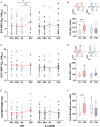The effects of local vibration inducing a tonic vibration reflex or movement illusion on acute modulations of corticospinal excitability
- PMID: 40167503
- PMCID: PMC12072240
- DOI: 10.1113/JP286689
The effects of local vibration inducing a tonic vibration reflex or movement illusion on acute modulations of corticospinal excitability
Abstract
Stimulation of muscle afferents by local vibration (LV) can lead to two distinct perceptual and motor responses: the tonic vibration reflex (TVR) or the movement illusion. This study aimed to evaluate the effect of TVR and movement illusion on corticospinal excitability. In two experiments, EMG activity of the vibrated flexor carpi radialis (FCR) muscle (80 Hz, 6 min) and the extensor carpi radialis (ECR) muscle were recorded. Illusion was assessed using questionnaires. LV conditions were adjusted to favour either TVR (visual attention focused on the vibrating wrist) or ILLUSION (hidden hand, visual attention focused on the EMG of the FCR muscle). Motor-evoked potential (MEP) and cervicomedullary motor-evoked potential (CMEP) were recorded at rest for both muscles before (10 and 0 min) and after (0 and 30 min) each LV condition. Only the TVR condition increased EMG of the FCR muscle (+490% compared to resting, P = 0.005), while movement illusion was greater in the ILLUSION condition (P < 0.001). Concerning the vibrated muscle at P0, TVR reduced the amplitude of CMEP (-13.8 ± 15.8%, P = 0.011) without altering MEP (0.3 ± 27.9%, P = 1), whereas the opposite occurred with movement illusion (i.e. CMEP: -4.5 ± 13.7%, P = 0.891; MEP: -25.1 ± 17.2%, P = 0.002). Cortical excitability (MEP/CMEP ratio) of the vibrated muscle was reduced by 24 ± 13.3% on average compared to values obtained before LV, only in the ILLUSION condition. In conclusion, this study highlights the relevance of measuring and reporting the perceptual and motor responses induced during LV, demonstrating that TVR and movement illusion partly determine the acute effects on the neural network. KEY POINTS: Tonic vibration reflex and movement illusion are rarely controlled and measured in studies investigating the effect of LV on corticospinal excitability. The application of LV with visual attention focused on the vibrated muscle promotes the presence of a tonic vibration reflex (TVR). The absence of visual feedback on the latter promotes the presence of an illusion of movement. The cortical excitability of the vibrated muscle is influenced differently according to the perceptual and motor responses induced during LV, with an opposite effect on the cortical excitability of the antagonist muscle. Improved control of LV application conditions, quantification of perceptual and motor responses, and reporting of results (e.g. EMG activity of the vibrated muscle or illusion of movement during the protocol) are required to enhance our understanding of the physiological mechanisms associated with LV use and, consequently, the effectiveness of LV as a therapeutic modality.
Keywords: alpha motoneuron excitability; corticospinal excitability; local vibration; movement illusion; tonic vibration reflex.
© 2025 The Author(s). The Journal of Physiology published by John Wiley & Sons Ltd on behalf of The Physiological Society.
Conflict of interest statement
The authors have no competing interests or conflicts of interest related to this work.
Figures






Similar articles
-
Acute effects of local vibration inducing tonic vibration reflex or illusion of movement on maximal wrist force production.J Appl Physiol (1985). 2024 Oct 1;137(4):800-813. doi: 10.1152/japplphysiol.00192.2024. Epub 2024 Aug 8. J Appl Physiol (1985). 2024. PMID: 39116345
-
Local vibration induces changes in spinal and corticospinal excitability in vibrated and antagonist muscles.J Neurophysiol. 2024 Feb 1;131(2):379-393. doi: 10.1152/jn.00258.2023. Epub 2024 Jan 10. J Neurophysiol. 2024. PMID: 38198664
-
Antagonist motor responses correlate with kinesthetic illusions induced by tendon vibration.Exp Brain Res. 1999 Feb;124(3):342-50. doi: 10.1007/s002210050631. Exp Brain Res. 1999. PMID: 9989440
-
Variation of corticospinal excitability during kinesthetic illusion induced by musculotendinous vibration.J Neurophysiol. 2023 Nov 1;130(5):1118-1125. doi: 10.1152/jn.00069.2023. Epub 2023 Sep 14. J Neurophysiol. 2023. PMID: 37706230
-
Corticospinal and Clinical Effects of Muscle Tendon Vibration in Neurologically Impaired Individuals. A Scoping Review.J Mot Behav. 2025;57(2):198-214. doi: 10.1080/00222895.2024.2441860. Epub 2024 Dec 22. J Mot Behav. 2025. PMID: 39709638
References
-
- Abbruzzese, M. , Minatel, C. , Reni, L. , & Favale, E. (2001). Postvibration depression of the H-reflex as a result of a dual mechanism: An experimental study in humans. Journal of Clinical Neurophysiology, 18, 460–470. - PubMed
-
- Amiez, N. , Martin, A. , Gaveau, J. , Julliand, S. , Papaxanthis, C. , & Paizis, C. (2024). Local vibration induces changes in spinal and corticospinal excitability in vibrated and antagonist muscles. Journal of Neurophysiology, 131(2), 379–393. - PubMed
-
- Avvantaggiato, C. , Casale, R. , Cinone, N. , Facciorusso, S. , Turitto, A. , Stuppiello, L. , Picelli, A. , Ranieri, M. , Intiso, D. , Fiore, P. , Ciritella, C. , & Santamato, A. (2021). Localized muscle vibration in the treatment of motor impairment and spasticity in post‐stroke patients: A systematic review. European Journal of Physical and Rehabilitation Medicine, 57(1), 44–60. - PubMed
MeSH terms
Grants and funding
LinkOut - more resources
Full Text Sources
